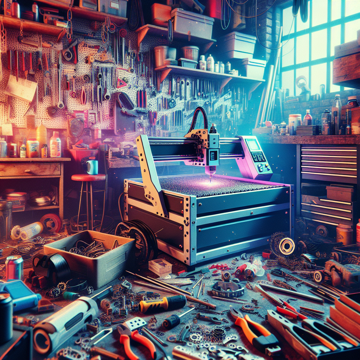AI Thinks, Robots Build, and Metal Flies: How Open Source and Next-Gen Tech Are Powering a Maker Revolution

If you think the future is far off, think again—because open-source AI is now writing research papers, ships are sailing themselves across oceans, and a $400 robot can slice steel in your garage. The only thing missing is a cloud of smart dust whispering secrets to your CNC machine.
Let’s start with the brainy side of things. Hugging Face, the open-source darling of the AI world, just dropped a research agent that mimics OpenAI’s state-of-the-art Deep Research tool—after a mere 24-hour coding blitz. The result? An AI bot that can comb the internet, piece together answers to fiendishly complex questions, and spit out reports that almost match OpenAI’s own, all without a corporate paywall. It’s already scoring over 55% on the GAIA benchmark, closing in on OpenAI’s numbers, and the code is open for anyone to tinker with[1]. For makers, hackers, or just the terminally curious, this means you now have a digital research assistant that lives on your laptop, not in a Silicon Valley walled garden.
But what’s the point of all this digital brainpower if you can’t bring your ideas into the real world? Enter the new wave of CNC plasma cutters—like the ArcDroid and its $400 DIY cousins—making precision metalwork as easy as tracing a line with your finger. Remember when plasma cutting meant sweating over bricks in your backyard? Now, with a bit of 3D printing and a cheap handheld torch, you can rig up a CNC cutter that carves steel with robotic accuracy. Even the pros are taking notes: commercial desktop machines now combine portability, shielded cabling, and smartphone-free interfaces so you never get tripped up by WiFi dropouts or RF noise. Whether you’re building a robot or just a killer bracket for your bike, advanced fabrication has gone from factory-floor fantasy to garage reality[4][5].
Of course, all these machines talking to each other means we need better ways for them to communicate—especially if we’re dreaming even bigger. Enter graphene nano-antennas, the latest trick in the quest for “smart dust” swarms. These flea-sized communicators, made from sheets of carbon barely thicker than a single atom, could let millions of micro-machines coordinate like a digital ant colony. Georgia Tech’s breakthrough means these antennas are so tiny and efficient, they blow past the limits of conventional radio or infrared, promising global-scale machine swarms that talk, think, and build together[2].
Meanwhile, AI isn’t just stuck in the cloud or your garage—it's literally crossing oceans. The Prism Courage, a giant cargo ship, just completed a 20,000km journey with an AI captain at the helm, dodging collisions and optimizing its route for maximum fuel savings. Autonomous navigation is already spreading from mega-freighters to ferries and electric boats, hinting at a not-so-distant future where ships, cars, and maybe your own DIY CNC creations navigate—solo and smarter—thanks to open algorithms and machine learning[3].
So, whether you’re coding, cutting, or dreaming up your own smart dust swarm, one thing is clear: the hacker ethos is alive and well, and the machines are learning fast.
1. https://arstechnica.com/ai/2025/02/after-24-hour-hackathon-hugging-faces-ai-research-agent-nearly-matches-openais-solution/
2. https://newatlas.com/graphene-nano-antennas-smart-dust-swarm/30373/
3. https://www.independent.co.uk/independentpremium/world/autonomous-cargo-ship-hyundai-b2095921.html
4. https://www.geeky-gadgets.com/arcdroid-cnc-desktop-plasma-cutter-05-10-2021/
5. https://hackaday.com/2024/05/03/plasma-cutter-gets-cnc-treatment-at-low-cost/